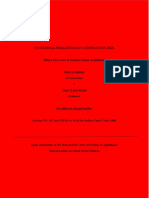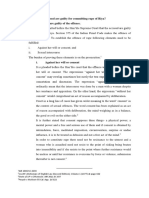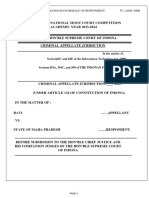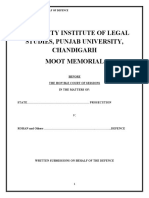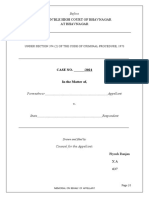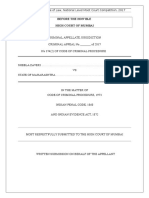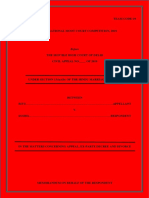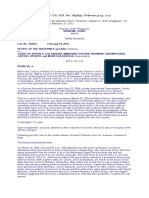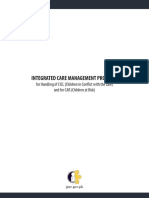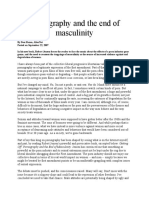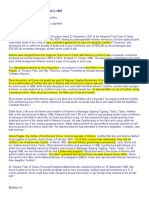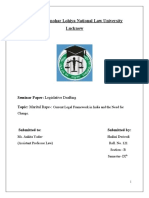Memorandum For Prosecution
Memorandum For Prosecution
Uploaded by
Aditi RaghuvanshiCopyright:
Available Formats
Memorandum For Prosecution
Memorandum For Prosecution
Uploaded by
Aditi RaghuvanshiOriginal Description:
Original Title
Copyright
Available Formats
Share this document
Did you find this document useful?
Is this content inappropriate?
Copyright:
Available Formats
Memorandum For Prosecution
Memorandum For Prosecution
Uploaded by
Aditi RaghuvanshiCopyright:
Available Formats
IV INTERNAL TRIAL ADVOCACY COMPETITION Page |1
“IV INTERNAL TRIAL ADVOCACY COMPETITION, 2018”
Before The Court of Sessions Judge, Jagdishpur
State of Indiana
(Prosecution)
Guru Ji and Kaant
(Defence)
For offences charged under:
Section 376, 107 and 120-B r/w 34 of the Indian Penal Code, 1860
Upon submission to the Honourable Court of Session at Jagdishpur
Memorandum on behalf of the Prosecution
MEMORANDUM ON BEHALF OF PROSECUTION
IV INTERNAL TRIAL ADVOCACY COMPETITION Page |2
TABLE OF CONTENTS
TABLE OF CONTENT………………………………………………………….
TABLE OF ABBREVIATION………………………………………………….
INDEX OF AUTHORITIES…………………………………………………….
(A) BOOKS……………………………………………………………………
(B) LEXICONS……………………………………………………………….
(C) LEGISLATIONS/ CODES/ STATUTES……………………………….
(D) LEGAL DATABASE…………………………………………………….
(E) CASE LAWS……………………………………………………………...
STATEMENT OF JURISDICTION…………………………………………….
STATEMENT OF FACTS……………………………………………………….
STATEMENT OF CHARGES…………………………………………………..
SUMMARY OF ARGUMENTS…………………………………………………
ARGUMENTS ADVANCED……………………………………………………
ISSUES………………………………………………………………………………….
ISSUE I:
[1] Whether accused no. 1 (Sant Maharaj Ji) and accused no.2 (Kaant) can be charged
under Section 376 of Indian Penal Code, 1860?
ISSUE II:
[2] Whether accused no. 1 and accused no. 2 can be charged under section 120-B r/w
Section 34 of Indian Penal Code?
ISSUE III:
[3] Whether accused no. 1 can be charged under Section 107 of Indian Penal Code?
PRAYER……………………………………………………………………………………….
MEMORANDUM ON BEHALF OF PROSECUTION
IV INTERNAL TRIAL ADVOCACY COMPETITION Page |3
LIST OF ANNEXURES………………………………………………………………………
LIST OF ABBREVIATIONS
1. Indian Penal Code I.P.C.
2. First Information Report F.I.R.
3. Read with r/w
4. Criminal Procedure Code Cr.P.C.
5. Indian Evidence Act I.E.A.
6. Section Sec.
7. Versus V.
8. Page Pg.
9. Edition Ed.
10. All India Report AIR
11. Supreme Court Cases SCC
12. Honourable Hon’ble
13. Under Section u/s
MEMORANDUM ON BEHALF OF PROSECUTION
IV INTERNAL TRIAL ADVOCACY COMPETITION Page |4
INDEX OF AUTHORITIES
(A) BOOKS.
1. I, Basu D.D. Cr.P.C. 1973, (5th Ed. Lexis Nexis).
2. II, Basu D.D. Cr.P.C. 1973, (5th Ed. Lexis Nexis).
3. Ramasubramaniyam P., Criminal Major Act 2013.
4. Gaur K.D., Indian Penal Code, 1860.
5. Williams & Glanville, Criminal Law, (2nd Ed. 2011).
6. Sarkar, Law of Evidence, (17th Ed. 2011).
7. Ratanlal & Dhirajlal, The Law of Evidence, (23rd Enlarged Ed. 2011).
8. Ratanlal & Dhirajlal, The Indian Penal Code, (31st Enlarged Ed. 2006).
9. Ratanlal & Dhirajlal, The Code of Criminal Procedure, (17th Ed. 2010).
10. IV, Sarvaria, S.K, Indian Penal Code, (10th Ed. 2008).
11. III, Sarvaria, S.K, Indian Penal Code, (10th Ed. 2008).
12. II, Sarvaria, S.K, Indian Penal Code, (10th Ed. 2008).
(B) LEGISLATIONS / CODES / STATUTES
1. The Code of Criminal Procedure, 1973 (Act No. 2 of 1974).
2. The Indian Evidence Act, 1872 (Act No. 1 of 1872).
3. The Indian Penal Code, 1860 (Act No. 45 of 1860).
(C) LEGAL DATABASE
1. www.scconline.com
2. www.lexisnexis.com
3. www.manupatra.com
4. www.heinonline.com
(D) CASE LAWS
1. Saleha Khatoon v. State of Bihar
2. Ghanshyam Mishra v. State
3. Mohd. Zuber Noor Mohammed Chagwadia v. State of Gujarat
MEMORANDUM ON BEHALF OF PROSECUTION
IV INTERNAL TRIAL ADVOCACY COMPETITION Page |5
4. Mahmood Farooqui v. State (Govt. of NCT of Delhi)
5. Noor Mohammad v. State of Maharashtra
6. Ram Tahal and Ors. v. State of U.P.
7. Rajesh Govind Jagesha v. State of Maharashtra
8. Manik Das and Ors. v. State of Assam
9. Ch. Pulla Reddy and Ors. v. State of Andhra Pradesh
10. Pradeep Kumar v. Union of India
11. Dani Singh v. State of Bihar
12. R.K.Dalmia v. Delhi Administration
13. State of Maharashtra v. Som Nath Thapa
14. Devender Pal Singh v. State National Capital Territory of Delhi and Ors.
15. State of Himachal Pradesh v. Krishna Lal Pradhan
16. Firozuddin Basheeruddin and Ors. v. State of Kerela
17. Malan and Ors. v. state of Bombay and Ors.
18. Brijlal v. State (Delhi Admn.)
19. Randhir Singh and Anr. v. State of Punjab
MEMORANDUM ON BEHALF OF PROSECUTION
IV INTERNAL TRIAL ADVOCACY COMPETITION Page |6
STATEMENT OF JURISDICTION
The prosecution have approached the Hon’ble Court of the Additional Chief Judicial
Magistrate of Jagdishpur under section 177 of Cr.P.C
Section 177- Ordinary place of inquiry and trial.
Every offence shall ordinarily be inquired inland tried by a Court within whose local
jurisdiction it was committed.
Section 209- Commitment of case to Court of Session when offence is triable
exclusively by it
When in a case instituted on a police report or otherwise, the accused appears or is
brought before the Magistrate and it appears to the Magistrate that the offence is triable
exclusively by the Court of Session, he shall-
(a) commit, after complying with the provisions of section 207 or section 208, as the case
may be, the case to the Court of Session, and subject to the provisions of this Code
relating to bail, remand the accused to custody until such commitment has been made;]
(b) subject to the provisions of this Code relating to bail, remand the accused to custody
during, and until the conclusion of, the trial;
(c) send to that Court the record of the case and the documents and articles, if any, which
are to be produced in evidence;
(d) notify the Public Prosecutor of the commitment of the case to the Court of Session.
MEMORANDUM ON BEHALF OF PROSECUTION
IV INTERNAL TRIAL ADVOCACY COMPETITION Page |7
STATEMENT OF FACTS
Eila, aged 17 years, a student of GMC Public School and a resident of Jagdishpur District.
The whole family of Eila were a blind disciple of Guru “Sant Maharaj Ji” except Eila who
believed in science and knew that Guru ji had created a great superstitious veil of faith over
everyone, but due to the pressure and a dire faith of her grandmother she had to follow the
instructions provided by Guru Ji. At instances she even tried to question Guru ji’s teachings
but could not do much as the whole locality had a great amount of faith in Guru ji and thus
would not agree to her sayings. Eila was a school going girl, for the route to the school she
and her younger brother (Prem) used to take a turn through the sabzi market of that area.
Ricky (18 years) was a classmate of Eila wh joined the sae school 1.5 years back. His home
was situated on the 2nd floor of the same building where his shop was located in the sabzi
market. Ricky’s family was also a follower of Guru Ji and thus sometimes he saw Eila in the
aashram as well. Kaant, who shop was located opposite to the shop of Ricky, observed that
Ricky was developing a soft corner for Eila who being a teenager was shy enough to accept
that fact. Kaant taking the advantage of the situation tried to manipulate Ricky’s innocent
feelings into a desperate desire. In one of his statements Kaant who was showing he to be the
well-wisher of Ricky stated that he will help him get the girl before “Poornima Day”. Ricky
owing his trust on Kannt started following his instructions subsequent to which their (Ricky
and Kaant) chatting on WhatsApp started. Within some period of time Kaant wooed Ricky’s
trust and showed the teenage boy ways to impress a girl. Ricky and Eila became close
friends; the exchange of letters started between them as Eila didn’t have a phone. Ricky used
to keep Kaant updated with the conversations between him and Eila, and thus Kaant had the
access to their letters as well, which he used to further share with Guru Ji. Ricky and Eila
used to share each and everything, in one of the letters Eila told Ricky that how she did not
believed in the blind faith for Guru ji and that he was a shame in the name of religion. Also,
in another letter she told about the rashes that she had on her back about which even her
family had no knowledge as they would send her for medication to the Guru Ji. On 23/08/18,
Eila’s grandmother (Shanta Devi) asked her to take blessings of Guru Ji, for which when Eila
bent to do the same, Guru Ji asked her to take care of her rashes, which left her in shock,
which got added with Guru ji’s statement regarding her and Ricky’s friendship, followed by
the presence of the letters in the hands of one of the sevika (Seema) of Guruji’s aashram.
Also, in conversation with Shanta Devi, Guru Ji stated that he always had his eyes on Eila.
Guru ji further told Shanta that in order to remove the bad omen surrounding Eila, they
MEMORANDUM ON BEHALF OF PROSECUTION
IV INTERNAL TRIAL ADVOCACY COMPETITION Page |8
should conduct a shuddhi pooja for her, for which the present day was the most auspicious as
it happened once in a week. Accordingly, Eila was taken to the darbar for pooja where other
sevikas used to stay. Eila who usually revolted could not do the same this time as she was
scared enough. Seema escorted Eila, gave her the dinner, gave her saffron clothes for the said
pooja and took her to the healing room which did not give positive vibes. The dinner made
Eila feel heavy and dizzy. As soon as Eila entered the room she saw a bunch of people
alongwith Guru Ji, she was asked to lie down next to Guru Ji, the gestures made her feel
uncomfortable and when asked was told that to be a part of the pooja. Adding to all of what
caught her attention was Kaant standing in saffron clothes as sevak. Eila was provided with a
‘holy water’ to drink that weakened her senses. A chain of events took place after that, the
sevaks were asked to move out, after which Eila could feel someone touching her legs, a lot
of pain occurred in her abdomen and chest area, but she couldn’t react to it. Even though
when tried to revolt, someone pulled her back and closed her eyes, subsequently she felt
unconscious and woke about after an hour or so. It was difficult for Eila to walk and had a lot
of pain, after reaching home she observed blood between her legs. As soon as she talked
about it to her mother she was taken to the nearest hospital, after the examination, Doctor
Pradeep informed that Eila had been raped. Subsequently, the police reached the hospital and
the FIR was lodged against Sant Maharaj Ji and Kaant, resulting Eila and her family received
a lot of backlash from the followers of Guru Ji, due to which they had to withdraw the FIR.
But, Eila’s maternal uncle (Om Prakash), a lawyer by profession informed about all of this to
the media. Soon, this news spread as the accused was a known public figure. The police had
to struggle and even had to impose lathi charge in order to make way to arrest Guru Ji, only
to see that in the time Guru Ji had escaped. Meanwhile, the followers tried to victimise Eila
by blaming her and by circulating her personal letters on social media. Due to the sensitivity
of the matter, it caught attention of the State Government who was concerned for the
maintenance of public order. The statement of Eila was recorded and medical test was done.
In order to escape from the police, Guru Ji got himself admitted in Jeevan Life Care Hospital
stating medical emergency despite the hospital maintaining that he is fit to be discharged.
However, the Jagdishpur Police arrested Guru Ji and subsequently Kaant.
MEMORANDUM ON BEHALF OF PROSECUTION
IV INTERNAL TRIAL ADVOCACY COMPETITION Page |9
STATEMENT OF CHARGES
Accused No. 1
Sant Maharaj Ji has been charged under Sections 3761, 1072, 120-B3 and 344 of Indian
Penal Code, 1860.
Accused No. 2
Kaant has been charged under Sections 376, 120-B and 34 of Indian Penal Code, 1860.
1
376. Punishment for rape.—
(1)Whoever, except in the cases provided for by sub-section (2), commits rape shall be punished with
imprisonment of either description for a term which shall not be less than seven years but which may be for life
or for a term which may extend to ten years and shall also be liable to fine unless the women raped is his own
wife and is not under twelve years of age, in which cases, he shall be punished with imprisonment of either
description for a term which may extend to two years or with fine or with both: Provided that the court may, for
adequate and special reasons to be mentioned in the judgment, impose a sentence of imprisonment for a term of
less than seven years.
2
Abetment of a thing.—A person abets the doing of a thing, who—
(First) — Instigates any person to do that thing; or
(Secondly) —Engages with one or more other person or persons in any conspiracy for the doing of that thing, if
an act or illegal omission takes place in pursuance of that conspiracy, and in order to the doing of that thing; or
(Thirdly) — Intentionally aids, by any act or illegal omission, the doing of that thing. Explanation 1.—A person
who, by wilful misrepresentation, or by wilful concealment of a material fact which he is bound to disclose,
voluntarily causes or procures, or attempts to cause or procure, a thing to be done, is said to instigate the doing
of that thing. Illustration A, a public officer, is authorized by a warrant from a Court of Justice to apprehend Z.
B, knowing that fact and also that C is not Z, wilfully represents to A that C is Z, and thereby intentionally
causes A to apprehend C. Here B abets by instigation the apprehension of C. Explanation 2.—whoever, either
prior to or at the time of the commission of an act, does anything in order to facilitate the commission of that
act, and thereby facilitate the commission thereof, is said to aid the doing of that act.
3
Punishment of criminal conspiracy.—
(1) Whoever is a party to a criminal conspiracy to commit an offence punishable with death, 2[imprisonment for
life] or rigorous imprisonment for a term of two years or upwards, shall, where no express provision is made in
this Code for the punishment of such a conspiracy, be punished in the same manner as if he had abetted such
offence.
(2) Whoever is a party to a criminal conspiracy other than a criminal conspiracy to commit an offence
punishable as aforesaid shall be punished with imprisonment of either description for a term not exceeding six
months, or with fine or with both.
4
Acts done by several persons in furtherance of common intention.—When a criminal act is done by several
persons in furtherance of the common intention of all, each of such persons is liable for that act in the same
manner as if it were done by him alone.
MEMORANDUM ON BEHALF OF PROSECUTION
I V I N T E R N A L T R I A L A D V O C A C Y C O M P E T I T I O N P a g e | 10
SUMMARY OF ARGUMENTS
ISSUE- I
Whether accused no. 1 (Sant Maharaj Ji) and accused no. 2 (Kaant) can be charged
under Section 376 of the Indian Penal Code, 1860?
It is humbly submitted before the Hon’ble Court that both the accused are guilty under
section 376 of the Indian Penal Code, 1860. The submissions are based on the prima facie
evidences including the medical report, the statement of the prosecutrix and the
circumstantial inferences.
ISSUE- II
Whether accused no. 1 and accused no. 2 can be charged under section 120-B r/w
Section 34 of Indian Penal Code?
It is humbly submitted before the Hon’ble Court that both the accused to be charged under
section 120-B r/w section 34 of the Indian Penal Code as both of them had a common
intention of blackmailing Eila (prosecutrix) and then taking undue advantage of the same and
in order to achieve it they conspired against her and committed a heinous offence with her.
ISSUE-III
Whether accused no. 1 can be charged under Section 107 of Indian Penal Code?
The prosecution would humbly like to submit that the accused no.1 should be charged under
Section 107 of the Indian Penal Code as the evidences are pointing towards one thing, i.e.
Guru Ji has abetted Kaant so that he could receive all the information related to Eila.
MEMORANDUM ON BEHALF OF PROSECUTION
I V I N T E R N A L T R I A L A D V O C A C Y C O M P E T I T I O N P a g e | 11
ARGUMENTS ADVANCED
ISSUE-I
[1] Whether accused no. 1 (Guru Ji) and accused no. 2 (Kaant) can be charged under
Section 376 of the Indian Penal Code, 1860?
It is most humbly submitted that the accused no. 1 (Guru Ji) and accused no. 2 would be
punished under section 376 of the Indian Penal Code as they had forceful intercourse with the
victim (Eila). The victim stated that on 23/08/2018 she went to Guru Ji’s darbar for blessings
but what followed after it left her in shock. Guru Ji, in the name of ‘shudhi-pooja’ attempted
a heinous offence with Eila along with Kaant aiding him for the same.
To establish our case and to charge the accused under Section 376, we would go through the
chain of events connecting them with the precedents that would put forward that in the
present scenario rape was committed with the victim while she was intoxicated.
[1.1] Meaning of ‘Rape’:
‘Rape’ literally means a forcible seizure. It signifies in common terminology, “as the
ravishment of a woman without her consent, by force, fear, or fraud” or “the carnal
knowledge of a woman against her will”.5
[1.2] Statutory provision of ‘Rape’:
A man is said to committed ‘rape’ if he had sufficed any or all of the ingredients mentioned
under Section 3756. It provides with four scenarios, (Penetrates his penis, to any extent, into
the vagina, mouth urethra or anus of a woman or makes her to do so with him or any other
person) of physical contact that would amount to rape, also it states about seven descriptions
5
Textbook on Indian Penal Code, K.D. Gaur, 6th Edn., (2016) p. 881.
6
Rape.—A man is said to commit “rape” who, except in the case hereinafter excepted, has sexual intercourse
with a woman under circumstances falling under any of the six following descriptions:—
(First) — against her will.
(Secondly) —Without her consent.
(Thirdly) — With her consent, when her consent has been obtained by putting her or any person in whom she is
interested in fear of death or of hurt.
(Fourthly) —With her consent, when the man knows that he is not her husband, and that her consent is given
because she believes that he is another man to whom she is or believes herself to be lawfully married.
(Fifthly) — With her consent, when, at the time of giving such consent, by reason of unsoundness of mind or
intoxication or the administration by him personally or through another of any stupefying or unwholesome
substance, she is unable to understand the nature and consequences of that to which she gives consent.
(Sixthly) — With or without her consent, when she is under sixteen years of age.
(Seventhly) – When she is unable to communicate her consent.
MEMORANDUM ON BEHALF OF PROSECUTION
I V I N T E R N A L T R I A L A D V O C A C Y C O M P E T I T I O N P a g e | 12
under which if the physical contact had taken place it would be sufficient for the commission
of the offence of rape.
In the present scenario the sexual intercourse with Eila was done without her consent while
she was dizzy and unconscious due to the intoxication given to her through the food and the
holy water. The Explanation attached to the abovementioned section states that “Consent
means an unequivocal voluntary agreement when the woman by words, gestures or any form
of verbal or non-verbal communication, communicates to participate in the specific sexual
act. And the proviso to the same states that ‘a woman who does not physically resist to the act
of penetration shall not by the reason only of that fact, be regarded as consenting to the sexual
act.”7
The facts of the case reveal that Eila throughout showed her opposing gestures, thus nowhere
it could be assumed that she gave her consent for the sexual intercourse and the whole act
took place without her consent. Due to the intoxication provided to her, she was not able to
resist much and thus could not physically resist.
[1.3] Establishment of evidences:
Saleha Khatoon v. State of Bihar8 the concept of consent was discussed, it was held that:
“Consent always means free will or voluntary act…..Consent obtained by deceitful means is
no consent and comes within the ambit of ingredients of the definition of rape.”
Ghanshyam Mishra v. State9 talked about the hymen tear, it was held that: “Even partial
penetration leading to the rupture of the hymen is sufficient to constitute rape, even though
there might not be deep penetration into the vaginal canal. The girl’s evidence was to the
effect that she felt severe pain and raised a cry, after which the petitioner desisted from the
act….The depth of the penetration is immaterial so far as the offence under Section 376
I.P.C. is concerned. ”
Mohd. Zuber Noor Mohammed Chagwadia v. State of Gujarat10 it was held that: “Where a
prosecutrix is a minor girl suffering from pain due to ruptured hymen and bleeding vagina
depicts same, minor contradictions in her statements they are not of much value, also absence
7
Explanation 2, Section 375, Indian Penal Code, 1860.
8
1989 CRILJ 202.
9
AIR 1951 ORI 78, 1957 CRILJ 469.
10
1999 Cr LJ 3419 (Guj).
MEMORANDUM ON BEHALF OF PROSECUTION
I V I N T E R N A L T R I A L A D V O C A C Y C O M P E T I T I O N P a g e | 13
of any injury on male organ of accused is no valid ground for innocence of accused,
conviction under section 375 IPC proper.”
The offence of rape not only affects the victim physically rather it imposes a great amount of
mental trauma, thus when it comes to obtaining victim’s statement, it might happen that the
victim may not be able to exactly portrait about the commission of that offence and thus
minor discrepancies would exist in the statements while recalling the offence.
In the case of Mahmood Farooqui vs. State (Govt. of NCT of Delhi)11 it was stated “While
saying so, this Court has taken into account that human memory cannot always be taken to be
sacrosanct. Theories propounded about the concept of a memory indicate that memory does
not work like a video recorder. If a person sees an event, he sees/receives only fragments of
such information from the circumstance which is sighted. Those fragments are then mixed
with other information from other sources viz any prior information, which is stored in
memory, and some kind of an expectation as to what would happen, as also, inferences which
could be derived from the set of circumstances or conclusions arrived at after the event has
occurred. All these conglomerate into an information which is then stored in a person's
memory with respect to that event. It has been scientifically proved that sometimes, such
memory could be accurate but it may not be necessary that under all circumstances it would
be the same what was perceived by that person.”
[1.4] Punishment for ‘Rape’:
The prosecution would like to humbly submit that both the accused to be punished under
Section 376 of the Indian Penal Code, as the chain of events and the evidences clearly
provide that the offence had been committed by the accused.
Clause (1) of section 37612 states that “Whoever, except in the cases provided for in sub-
section (2), commits rape, shall be punished with rigorous imprisonment of either description
for a term which shall not be less than seven years, but which may extend to imprisonment
for life, and shall also be liable for fine.
As it has been well established that the accused had committed rape with the victim, she was
intoxicated and there was no consent from her side for the involvement of sexual intercourse,
11
MANU/DE/2901/2017, para no. 93.
12
Indian Penal Code, 1860.
MEMORANDUM ON BEHALF OF PROSECUTION
I V I N T E R N A L T R I A L A D V O C A C Y C O M P E T I T I O N P a g e | 14
thus it clearly depicts that offence of rape has been committed by both the accused and
subsequently the shall be charged under section 376 for the commission of rape.
ISSUE-II
[2] Whether accused no. 1 and accused no. 2 can be charged under section 120-B r/w
Section 34 of Indian Penal Code?
The prosecution would like to humbly submit that both the accused to be charged and
punished under section 120-B r/w section 34 of the Indian Penal Code, as both of them had a
common intention of blackmailing Eila (prosecutrix) and then take undue advantage of the
same and in order to achieve it they conspired against her and committed a heinous offence
with her.
[2.1] Common Intention of the accused
All of the acts done by the accused were in furtherance of their common intention as Kaant
and Guru Ji both were in a gaining position. Also, in order to achieve this common intention
they did illegal acts and led to a criminal conspiracy. As defined under Section 34 13, states as
“When a criminal act is done by several persons in furtherance of the common intention of
all, each of such persons is liable for that act in the same manner as if it were done by him
alone.” Here, in the present scenario, Kaant who had the access to all the personal letters of
Ricky and was a follower of Guru Ji, it is very much possible that after reading Eila’s
statement in the letter that “she doesn’t know why people trust Guruji and that one day she’ll
try to lift the veil of faith from the eyes of people”14 might have made Kaant feel angry about
it as being a true follower and thus showed it to Guru Ji, resulting they formed a common
intention of taking revenge from Eila and conspired to conduct a criminal act in furtherance
of the same.
In Noor Mohammad v. State of Maharashtra15, it was held that “So far as Section 34, I.P.C. is
concerned; it embodies the principle of joint liability in the doing of a criminal act, the
13
Indian Penal Code, 1860.
14
Trial proposition, para no. 6
15
AIR 1971 SC 885.
MEMORANDUM ON BEHALF OF PROSECUTION
I V I N T E R N A L T R I A L A D V O C A C Y C O M P E T I T I O N P a g e | 15
essence of that liability being the existence of a common intention. Participation in the
commission of the offence in furtherance of the common intention invites its application.”
Although it is necessary to understand that there is a difference between same intention and
common intention, thus even though the acts of the accused may vary when observed in
general but if those different acts are in furtherance of the common intention, then both of
them would be prosecuted for the same. In the case of Mohan Singh v. State of Punjab16 it
was held that “The acts may be different, may vary in their character, but they are all actuated
by the same common intention. It is now well settled that the common intention required by
S.34 is different from the same intention or similar intention.”
In Ram Tahal and Ors. v. The State of U.P17, it was held that, “while dealing with the
applicability of Section 34 of the Indian Penal Code, a two-Judge Bench observed there is no
doubt that a common intention should be anterior in time to the commission of the crime
showing a pre-arranged plan and prior concert, and though it is difficult in most cases to
prove the intention of an individual, yet it has to be inferred from the act or conduct or other
relevant circumstances of the case.”
In Rajesh Govind Jagesha v. State of Maharashtra18, “a two-Judge Bench has held that the
existence of common intention can be inferred from the attending circumstances of the case
and the conduct of the parties. No direct evidence of common intention is necessary. For the
purpose of common intention, even the participation in the commission of the offence need
not be proved in all cases.” Thus, even in the this case, there is no direct evidence of Guru Ji
and Kaant’s prior cotact but then too through victim’s statement, through the existence of
letters in Guru Ji’s aashram to which only Kaant had access through Ricky, all of these
connected dots and the circumstantial evidences show that there was a connect between the
two accused and that both of them had a common intention.
In Manik Das and Ors. v. State of Assam19, it was held that “The Section does not say "the
common intention of all", nor does it say "and intention common to all". Under the provisions
of Section 34 the essence of the liability is to be found in the existence of a common intention
animating the accused leading to the doing of a criminal act in furtherance of such intention.”
Here, the leak of Eila’s personal letters to Guru Ji through led to a creation of fear in Eila’s
16
AIR 1963 Supreme Court 174(1).
17
AIR 1972 SC 254.
18
AIR 2000 SC 160.
19
AIR 2007 SC 2274.
MEMORANDUM ON BEHALF OF PROSECUTION
I V I N T E R N A L T R I A L A D V O C A C Y C O M P E T I T I O N P a g e | 16
mind due to which she could not revolt and Guru Ji received an opportunity of committing
rape with her.
In Ch. Pulla Reddy and Ors. v. State of Andhra Pradesh20, it was held that “Section 34 is
applicable even if no injury has been caused by the particular accused himself. For applying
Section 34 it is not necessary to show some overt act on the part of the accused.”
In Pradeep Kumar v. Union of India21it was held that “Common intention can be proved
either from direct evidence or by inference from the acts or attending circumstances of the
case and conduct of the parties.”
In Dani Singh v. State of Bihar22 it was held that “To prove joint liability u/s 34 of I.P.C.,
existence of ‘common intention’ and ‘participation in crime’ both are essential but physical
presence at the scene of offence is not always necessary.”
[2.2] Criminal Conspiracy by the accused
The prosecution would like to humbly submit that the accused to be charged under Section
120-B23 as the circumstances, chain of events and the evidences show that the ingredients
necessary to charge an accused under section 120-B has been fulfilled here. As Defined under
Section 120-A24 , criminal conspiracy means “When two or more persons agree to do, or
cause to be done,-
(1) an illegal act, or
(2) an act which is not illegal means by illegal means, such an agreement is designated a
criminal conspiracy:”
Here, in this case an illegal act, i.e. rape has been committed which is itself is sufficing the
whole plot and thus demands the punishment of the accused under Section 120-B. For an
offence u/s 120-B of I.P.C. which states as “(1) Whoever is a party to a criminal conspiracy
to commit an offence punishable with death, imprisonment for life or rigorous imprisonment
for a term of two years or upwards, shall where no express provision is made in this Code for
the punishment of such a conspiracy, be punished in the same manner as if he had abetted
such offence. (2) Whoever is a party to a criminal conspiracy other than a criminal
20
AIR 1993 SC 1899.
21
(2006) 10 SCC 608.
22
(2005) SCC (Cri) 127.
23
Indian Penal Code, 1860.
24
Indian Penal Code, 1860.
MEMORANDUM ON BEHALF OF PROSECUTION
I V I N T E R N A L T R I A L A D V O C A C Y C O M P E T I T I O N P a g e | 17
conspiracy to commit an offence punishable as aforesaid shall be punished with
imprisonment of either description for a term not exceeding six months, or with fine or both.”
The prosecution need not necessarily prove that the conspirators expressly agreed to do or
cause to be done the illegal act, the agreement may be proved by necessary implication.25
In the case of R.K.Dalmia v. Delhi Administration26 it was held that “it is not necessary that
each member of the conspiracy must know all the details of the conspiracy. The offence can
be proved largely from the inferences drawn from the acts or illegal omission committed by
the conspirators in pursuance of a common design.” Thus, even if Kaant did not have the
exact idea that what crime Guru Ji was going to commit, that cannot regarded as a shield for
him to escape the liability.
In State of Maharashtra v. Som Nath Thapa27 , it was held that “the prosecution has not to
establish that a particular unlawful use was intended, so long as the goods or service in
question could not be put to any lawful use. Finally, when the ultimate offence consists of a
chain of actions, it would not be necessary for the prosecution to establish, to bring home the
charge of conspiracy, that each of the conspirators had the knowledge of what the
collaborator would do, so long as it is known that the collaborator would put the goods or
service to an unlawful use.”
In Devender Pal Singh vs. State National Capital Territory of Delhi and Ors.28, it was held
that “The essence of a criminal conspiracy is the unlawful combination and ordinarily the
offence is complete when the combination is framed. From this, it necessarily follows that
unless the statute so requires, no overt act need be done in furtherance of the conspiracy, and
that the object of the combination need not be accomplished, in order to constitute an
indictable offence. Law making conspiracy a crime is designed to curb immoderate power to
do mischief which is gained by a combination of the means.” Further it states that “For an
offence punishable under Section 120B, prosecution need not necessarily prove that the
perpetrators expressly agree to do or cause to be done illegal act; the agreement may be
proved by necessary implication.”
25
Sarkar, Law of Evidence, 13th Edn., (1990), p 491.
26
AIR 1962 SC 1821.
27
AIR 1996 SC 1744.
28
MANU/SC/0217/2002.
MEMORANDUM ON BEHALF OF PROSECUTION
I V I N T E R N A L T R I A L A D V O C A C Y C O M P E T I T I O N P a g e | 18
In State of Himachal Pradesh v. Krishna Lal Pradhan29, it was observed that “the offence of
criminal conspiracy consists in a meeting of minds of two or more persons for agreeing to do
or causing to be done an illegal act by illegal means, and the performance of an act in terms
thereof. It is further observed: If pursuant to the criminal conspiracy the conspirators commit
several offences, then all of them will be liable for the offences even if some of them had not
actively participated in the commission of the offences.”
In Firozuddin Basheeruddin and Ors. v. State of Kerala30 it was held that “Conspiracy is not
only a substantive crime. It also serves as a basis for holding one person liable for the crimes
of others in cases where application of the usual doctrines of complicity would not render that
person liable. Thus, one who enters into a conspiratorial relationship is liable for every
reasonably foreseeable crime committed by every other member of the conspiracy in
furtherance of its objectives, whether or not he knew of the crimes or aided in their
commission.”
ISSUE-III
[3] Whether accused no. 1 can be charged under Section 107 of Indian Penal Code?
The prosecution would humbly like to submit that the accused no.1 should be charged under
Section 10731 as the evidences are pointing towards one thing, i.e. Guru Ji has abetted Kaant
so that he could receive all the information related to Eila, her relationship with Kaant and
her views towards Guru Ji and all of this done with a mala fide intention. The actions of
Kaant were backed by the ideas provided through Guru Ji and as sson as he got the chance to
use the information extracted with the help of Kaant, he used it against Eila for the
commission of rape with her.
[3.1] statutory provision of Abetment
Abetment as defined in I.P.C. states as “a person abets the doing of a thing, who—
(First) — Instigates any person to do that thing; or
29
1987 (2) SCC 17.
30
2001 (7) SCC 596
31
Indian Penal Code. 1860.
MEMORANDUM ON BEHALF OF PROSECUTION
I V I N T E R N A L T R I A L A D V O C A C Y C O M P E T I T I O N P a g e | 19
(Secondly) —Engages with one or more other person or persons in any conspiracy for the
doing of that thing, if an act or illegal omission takes place in pursuance of that conspiracy,
and in order to the doing of that thing; or
(Thirdly) — Intentionally aids, by any act or illegal omission, the doing of that thing.”
The person who instigates the commission of a crime or advice and encourages others to
commit it.32 ‘Abet’- meaning to aid; to assist or to give aid; to command, to procure, or to
counsel; to countenance; to encourage, counsel, induce or assist to encourage or to set on to
commit.33
[3.2] Essential conditions for Abetment
In the case of Malan and Ors. vs. State of Bombay and Ors.34, it was stated that “It is well
known that an act of abetment may take place in one of three ways:
1. Instigation,
2. Conspiracy, or
3. Intentional aid.”
In the present facts of the case the abetment had taken place through conspiracy between
Guru Ji and Kaant. A person is said to abet the commission of an offence by conspiracy, if he
enters into an agreement with one or more persons to do a legal act by illegal means, or to do
an illegal act, and some act is done in pursuance thereof.35 The intention is held to be
continued and renewed as to all its members wherever and whenever any member of the
conspiracy acts in furtherance of the common design.36 Her, Kaant acted in furtherance of the
conspiracy between him and Guru Ji, by transferring the letters of Ricky and Eila.
Section 10837 defines the word ‘Abettor’ as “A person abets an offence, who abets either the
commission of an offence, or the commission of an act which would be an offence, if
committed by a person capable by law of committing an offence with the same intention or
knowledge as that of the abettor.” Guru ji abetted Kaant to keep an eye on Eila and to transfer
her personal information to him. Subsequently, Kaant acted upon the same. Ricky shared his
32
Black’s Law Dictionary.
33
Corpus Juris Secundum.
34
MANU/MH/0097/1960.
35
Textbook on Indian Penal Code, K.D.Gaur, 6th Edn.,p.279.
36
Stephen’s General View of the Criminal Law, 2nd Edn., p 69.
37
Indian Penal Code, 1860.
MEMORANDUM ON BEHALF OF PROSECUTION
I V I N T E R N A L T R I A L A D V O C A C Y C O M P E T I T I O N P a g e | 20
personal letters with Kaant with immense trust on him but Kaant took advantage of it and
acted as described by Guru ji.
In Brijlal v. State (Delhi Admn.)38 the Delhi High court observed that “to bring the case
within the ambit of Section 107, IPC, some active steps must be taken by work or action with
intent to instigate principal or principals and that encouragement does not, of necessity,
amount to aiding or abetting. It may be intentional or unintentional.”
[3.3] Mental process of instigating
In Randhir Singh and Anr. v. State of Punjab39 it was held that “Abetment involves a mental
process of instigating a person or intentionally aiding that person in doing of a thing. In cases
of conspiracy also it would involve that mental process of entering into conspiracy for the
doing of that thing.” As Guru ji had quite a influence over Kaant, thus it is very much
possible that on the day of the commitment of the offence he might have instigated Kaant in
such a manner that he would also have agreed for becoming part of that heinous offence.
38
MANU/DE/0524/1984.
39
(2004) 13 SCC 129.
MEMORANDUM ON BEHALF OF PROSECUTION
I V I N T E R N A L T R I A L A D V O C A C Y C O M P E T I T I O N P a g e | 21
PRAYER
Wherefore, in the light of the issues raised, arguments advanced and authorities cited, it is
most humbly and respectfully prayed before this Hon’ble Court to adjudge and declare that:
1. Accused No.1 Guru Ji is guilty for the offence u/s section 376, section 107 and
section 120-B r/w section 34 of the Indian Penal Code.
2. Accused No. 2 Kaant is guilty for the offence u/s section 376 and section 120-B r/w
section 34 of the Indian Penal Code.
Any other order as it deems fit in the interest of equity, justice and good conscience.
For This Act of Kindness, the prosecution shall be Duty Bound Forever Pray.
Date: Sd/-
Place: (Counsel for Prosecution)
MEMORANDUM ON BEHALF OF PROSECUTION
I V I N T E R N A L T R I A L A D V O C A C Y C O M P E T I T I O N P a g e | 22
ANNEXURE- 1
MEDICAL EXAMINATION REPORT
SANT VIHAR MEDICAL HOSPITAL
PM No. 1234 Date: 24/08/2018
Name of Victim: EILA
Sex: Female
Age: 17
Height: 5 feet 1 inches
Weight: 47 kg
Habits: N.A
Home Address: Block 13, Sant Vihar
Time of event: On 23/08/2018 about 25 hours before the Examination.
Identification Marks: mole on left thigh
By: P. Kumar
Clothes: Saffron salwar-kameez
i. General Physical Examination:
a) Emotional / mental status: - STABLE
b) BP: High; Pulse: Low; Respirations: Normal; Height: No change; Weight: No change;
c) Nutrition: N/A
d) Signs of intoxication by drugs & / or alcohol: No
e) Examination of clothes (if same as those worn at the time of assault). For evidence of tears,
loss of parts, stains, other foreign materials etc.
f) Stains / foreign materials on the body (including Pubic hairs & fingernails): BLOOD
STAINS
g) Gait of victim: N/A
h) Abdominal Examination with Spl. Ref. to pregnancy: N/A
ii Injuries on Body (With Spl. Reference to Signs of struggle & including the age of
injuries. If there is a history of buccal/anal penetration & bite marks, appropriate swabs
should be taken as indicated).
MEMORANDUM ON BEHALF OF PROSECUTION
I V I N T E R N A L T R I A L A D V O C A C Y C O M P E T I T I O N P a g e | 23
a) Head Neck Face: BITES ON THE NECK
b) Breasts: BITES AND PINCHES
c) Upper limbs: N/A
d) Buttocks: SWOLLEN
e) Inner aspect of thighs: BITES
f) Other areas if any: N/A
iii. Local Examination of Genital / Perineal areas (For Documentation of Injuries)
(a) Labia Majora: N/A (b) Labia Minora: N/A
(c) Clitoris: STIMULATED
(d) Fourchette & Interoitus / Vagina: FORCED INTERCOURSE (e) Hymen Intact / Torn:
TORN
The position of Tears: BOTH SIDES, 3 O’clock. Age of Tears: FRESH (f) E/o Perineal Tear
if any: N/A
(g) Urethra: N/A
(h) Physical Signs of S.T.D: RASHES (i) Anus: REDDISH
(j) Any other findings: - N/A
iv. Specific examinations (wherever facilities exists and if indicated)
a) Toluidine blue dye test: N/A
b) Wet mount slide test: N/A
c) UV light exam. Of clothes and skin: N/A
d) Anoscopic / colposcopic exam: N/A
v. Provisional opinion regarding sexual assault:
After examining the victim, bearing above mentioned identification marks and after one day
of the incident, I/We am/are of the opinion that
1. Evidence of injuries to the genitals / anus with age of injuries.:- YES
2. Evidence of injuries related to non- penetrative assault.:- N/A
3. Evidence of injuries suggesting application of force / restrained with age of injuries.:-
YES
4. Results of wet mount slide examination for evidence of spermatozoa.:- YES
5. Evidence of Sexually Transmitted Infections.: YES
MEMORANDUM ON BEHALF OF PROSECUTION
I V I N T E R N A L T R I A L A D V O C A C Y C O M P E T I T I O N P a g e | 24
6. Evidence of drug / alcoholic intoxication.: YES
7. Any other important findings.:- FORCEFUL PENETRATION
Final opinion kept pending until the results of Forensic Science Laboratory examination and
follow up examination.
The Consent of the parents of the victim Eila has been taken in advance for her medical
examination. She was brought to the hospital by the Parents only.
Important note: It is mandatory to enter the brief observations (Serial no.1-7 above) relevant
to the title in the form of handwritten remarks, i.e. “present / absent” and the matter like the
age of injury and ultra-brief justification in support of your remarks.
Sd/-
Dr. Pradeep Kumar
Medical Officer
MEMORANDUM ON BEHALF OF PROSECUTION
I V I N T E R N A L T R I A L A D V O C A C Y C O M P E T I T I O N P a g e | 25
ANNEXURE- 2
REPORT OF INVESTIGATION OFFICER
In the Court of the Additional Chief Judicial Magistrate, Jagdishpur
1. District: Jagdishpur PS: Sant Vihar, Year: 2018, FIR No. 149/18 Date: 026.08.2018
2. Charge sheet No. 120/2018
3. Date: 02/09/2018
4. Acts/ Section(s): IPC, 1860: Sections 376(1), 506 and 120B.
5. Charge sheet against: (i) Satyavrat Kumar @ Guru Ji s/o Shri Jagatram Kumar
(ii)Kaant Kumar s/o Shri Rambharose Kumar.
6. Offence, as mentioned, did occur as per the contents of the FIR.
7. Original Charge sheet, supplementary to follow against the rest of the accused.
8. I.O.: Lallan Top.; Rank: Sub Inspector
9. Complainant: Mr. Ram Singh
10. Particulars of accused persons charge sheeted:
Sl. No. Name of the Accused Accused Status
1. Guru Ji In Judicial Custody
2. Kaant In Custody
11. FIR is not false.
12. Result of the Medical Examination: Rape caused due to forceful sexual intercourse.
13. Therefore, there is possible that both the accused be tried for the offences punishable
under sections 376(1), 506 and 120B of Indiana Penal Code.
Notice served and dispatched.
Sd/-
Shahid Top
Circle Inspector
Lallan Top
Sub Inspector
MEMORANDUM ON BEHALF OF PROSECUTION
I V I N T E R N A L T R I A L A D V O C A C Y C O M P E T I T I O N P a g e | 26
ANNEXURE- 3
Whatsapp Conversation between Kaant and Ricky
MEMORANDUM ON BEHALF OF PROSECUTION
I V I N T E R N A L T R I A L A D V O C A C Y C O M P E T I T I O N P a g e | 27
MEMORANDUM ON BEHALF OF PROSECUTION
I V I N T E R N A L T R I A L A D V O C A C Y C O M P E T I T I O N P a g e | 28
ANNEXURE- 4
Letter I from Eila to Ricky
Hello Ricky,
Since I don’t have a phone so we’ll have to do it the retro style! I really had a great time at
the Mela yesterday and I’d like to thank you for the aesthetic bangles that you gifted me!! I’ll
always keep them with me. I am sorry I had to leave early for home yesterday, that’s because
we had to go to Sant Maharaji’s Darbar. My grandmother is his blind follower and we are
expected to do the same without a question. Though I have strong feeling that he is a sham
and the people here being illiterate and unaware fall in his traps.
Though these are just mere assumptions of my brain I really want to know the real reason
behind this and I want to lift the veil of faith from the eyes of people because Guru ji is a fake
person. I am really sorry I, however, did not intend to offend your feelings!
I really like you and spending time with you. Hope to spend more time with you! See you
tomorrow!
From~
Eila with love!
MEMORANDUM ON BEHALF OF PROSECUTION
I V I N T E R N A L T R I A L A D V O C A C Y C O M P E T I T I O N P a g e | 29
Letter II from Eila to Ricky
Hello Ricky,
Today school was good fun! I like sitting next to you in class with all the teasing going on,
that’s crazy. Don’t listen to your friends that much they are just fooling around! With board’s
exams around the corner, it’s getting really, I’m scared what shall happen, plus there is so
many syllabus to cover. How much have you covered?
The summer has taken a toll on me and because of this humid weather I have such bad rashes
all over my back and I’m scared that they’ll increase and work as a hindrance in my
preparations for the Board examinations. I’m scared, and I don’t want to tell my parents
about it as they’ll force me to get “Charnamrat” tonic from Sant Maharaj ji. And you know
how much of faith I have in Guru ji!!
Anyway, see you tomorrow! And I’ll bring your favorite lunch.
From~
Eila with love!
MEMORANDUM ON BEHALF OF PROSECUTION
I V I N T E R N A L T R I A L A D V O C A C Y C O M P E T I T I O N P a g e | 30
ANNEXURE- 5
WITNESS STATEMENTS
(Under section 161 of Code of Criminal Procedure)
PW 5: Ricky
Occupation: Student Age: 18 Sex: Male
Statement: I am Ricky, r/o Sant Vihar, Jagdishpur District. I live on the second floor in the
sabzi market lane where my shop is located. I'm a good friend of Eila and we study in the
same class. I’m still in shock to hear about this incident. I have come to know about this
incident by my father who slapped me by calling me irresponsible. I don’t know
anything about this incident, everything was just perfect and we were going so well with our
friendship. Even talking to her was a big task for me and a friendship would not have been
possible had I not received help from Kaant. Kaant bhaiya is very nice; he was very
supportive of my feelings towards Eila and helped me to get along with her. No one knew
about this except for Kaant Bhaiya.
DW 2: Guru Ji (Accused-1) Age: 62 Sex: Male
I am Sant Maharaj, r/o Sant Vihar, Jagdishpur District. My place of worship is where I
belong, Trilok Mandir Darbar. I’m very shocked to hear about Eila, She is a very
lovely child. I organized shudhi-pooja for her wellness as I saw sankat in her life. I knew
she is in grave danger always but poor girl, she never listened to me. On Pooja day, Eila got
late. She told me that she had to visit a friend, I enquired about some blood stains I saw on
her clothes to which she replied that she fell on the road while coming to darbar. She was
walking in a different posture as well. Sacred time was running for shuddhi Pooja, I forgot
about the blood stains and started preparing for Pooja. I did not know anything about the
incident. All I know is, I’m very spiritual being, son of god and I don’t have anything to do
with Eila but only shower her with blessings. Ask Ricky who was caught by my sevika on
Pooja day, he was hiding in the sacred hall when Pooja was happening. I always knew he has
something to do with the poor girl.
MEMORANDUM ON BEHALF OF PROSECUTION
I V I N T E R N A L T R I A L A D V O C A C Y C O M P E T I T I O N P a g e | 31
FIRST INFORMATION REPORT
1. District: JAGDISHPUR Year: 2018 FIR No: 230/2018 Date: 23/08/2018
2. Act: (i) Guruji: Indian Penal Code, 1860: Sections 376, 107, 120-B, 34.
(ii) Kaant: Indian Penal Code, 1860: Sections 376, 120-B, 34.
3. Occurrence of Offence: 23 August 2018, Time from: 3.30 p.m. Time to: 4:00p.m
4. Information recorded by: Inspector Lal Gopal Verma
5. Type of Information: Written / Oral: Oral complaint
6. Place of Occurrence: Direction/Distance from PS: about 2 Km east from Police Station.
Beat No: 14B
7. Complainant/Informant, Name: Mr. Ram Singh, Date of Birth: 16.10.1981 Nationality:
Indiana, Passport No: IB5032928, Date of Issue: 11.08.2007
8. Basis on which FIR is lodged: 1. Oral complaint by Mr. Ram Singh
9. Details of Known/Unknown/Suspected accused with full particulars: Suspected persons –
Sant Maharaj, Age 67, S/o Maharaj Adhikariand Jagdishwar Kaant, Age: 31 S/o Abrahim
Kaant
10. Reasons for delay in reporting by the complainant/informant: NA
11. Particulars of Injuries sustained: BITES AND PINCHES ON NECK, BLOOD STAINS
VISIBLE
12. Particulars of Post Mortem Report: NA
13. Post Mortem report done by: NA
14. Inquest report/ Unnatural death Case No. if any........... NA
15. Brief Facts of the Case: The complainant has stated that his daughter was raped in the
name of shudhi-pooja. The accused is a guru ji whom they follow and he fooled them into
chanting a Pooja to purify his daughter’s soul and for her bright career. The Complainant was
threatened of dire consequences if they complained. The complainant called the police when
his daughter mentioned abdomen pain, the victim was taken to the hospital and confirmed
“rape”.
16. Action taken (Since the above information reveals commission of offence (s) u/s as
mentioned at item No.2: Hardik Bhatia, Rank: S.I. has taken up the Investigation.
17. F.I.R. read over to complainant admitted to be correctly recorded and a copy given to the
complainant free of cost.
Sd/- Signature/ Thumb impression of Complainant/
MEMORANDUM ON BEHALF OF PROSECUTION
I V I N T E R N A L T R I A L A D V O C A C Y C O M P E T I T I O N P a g e | 32
Signature of Officer Name: Verma Rank: ASI
STATEMENT OF VICTIM (EILA)
Eila: My name is Eila and I’m 17 years old. Everyone in my family is a disciple of Guru &
Sant Maharaj Ji. It was a normal activity where my parents would ask me to accompany them
to the darbar and in return to which I would protest. In the same manner on 23/08/2018 my
parents asked me to go to the Darbar along with them. That day Guru ji in particular was
behaving really weird, he knew about the rashes I had on my body, about which no one knew.
Apart from Ricky whom I shared this personal piece of information as he really was a special
friend. In fact, Guru ji even knew about him and the letters we were exchanging. Later, Guru
ji told my tensed grandma that there was a shudhi-puja of which I should be a part of. But
obvious everyone in my family was in favour of me being a part of this puja. Later I was
taken to a room where I changed to saffron clothes. The food I had earlier was making me
dizzy and the dim lighted room made me uncomfortable but the sevaks told me this all was
just to make my soul pure. I was made to drink something which made me unconscious. And
later what followed can’t be expressed in words. I felt someone touching my legs and then I
felt a lot of pain in my abdomen area and chest area. When I tired waking up, someone forced
me back and I think I saw two known faces, one was a shopkeeper in the sabzi market and the
other, I’m not really sure, but it seemed as if it was ricky. But I’m not sure. After this
torturous puja I was sent with my parents to my home. On-going home I realised that apart
from pain I had blood between my legs, scared I told it to my mother.
MEMORANDUM ON BEHALF OF PROSECUTION
You might also like
- Harvey Weinstein AppealDocument77 pagesHarvey Weinstein AppealNational Content DeskNo ratings yet
- TAT 029 Prosecution Memorial.Document25 pagesTAT 029 Prosecution Memorial.Khushi ThakurNo ratings yet
- Gender and Societt: A Human Ecological ApproachDocument18 pagesGender and Societt: A Human Ecological ApproachKristineJoyP.Bayon-on0% (2)
- Memorial On Behalf of The Respondent!!Document17 pagesMemorial On Behalf of The Respondent!!Abhineet Jha100% (1)
- Moot Court Respondent FinalDocument18 pagesMoot Court Respondent FinalDanyal Ahmed100% (1)
- Upon Submission To The Hon'Ble Chief Justice of Republic of Amphissa and His Companion Justices of Supreme Court of Republic of AmphissaDocument30 pagesUpon Submission To The Hon'Ble Chief Justice of Republic of Amphissa and His Companion Justices of Supreme Court of Republic of AmphissaNikita DubeyNo ratings yet
- Moot Court MemorialDocument9 pagesMoot Court MemorialSreya Dasgupta67% (3)
- Iv Internal Trial Advocacy Competition: Memorandum On Behalf of The DefenseDocument30 pagesIv Internal Trial Advocacy Competition: Memorandum On Behalf of The DefenseAditi RaghuvanshiNo ratings yet
- Iv Internal Trial Advocacy Competition: Memorandum On Behalf of The DefenseDocument30 pagesIv Internal Trial Advocacy Competition: Memorandum On Behalf of The DefenseAditi RaghuvanshiNo ratings yet
- Appellant MemorialDocument31 pagesAppellant MemorialAditi Raghuvanshi100% (3)
- Appellant MemorialDocument31 pagesAppellant MemorialAditi Raghuvanshi100% (3)
- Tatyana Mamonova - Women and Russia. Feminist Writings From The Soviet Union PDFDocument299 pagesTatyana Mamonova - Women and Russia. Feminist Writings From The Soviet Union PDFnatalia antonova pankinaNo ratings yet
- In The Hon'Ble Supreme Court of India: (Criminal Appellate Jurisdiction)Document18 pagesIn The Hon'Ble Supreme Court of India: (Criminal Appellate Jurisdiction)Sarah KosarNo ratings yet
- Memorial On Acid Attack Case NewDocument19 pagesMemorial On Acid Attack Case NewLakita KambojNo ratings yet
- Moot Court 1Document27 pagesMoot Court 1pyaar passionNo ratings yet
- Before The Hon'Ble High Court of Orissa: N HE Atter FDocument12 pagesBefore The Hon'Ble High Court of Orissa: N HE Atter Frahul1996No ratings yet
- Moot Court Assingment 2 Petitioner Final Raj Vardhan AgarwalDocument13 pagesMoot Court Assingment 2 Petitioner Final Raj Vardhan Agarwalraj vardhan agarwalNo ratings yet
- Memorial (Repaired)Document20 pagesMemorial (Repaired)Yug Pratap Singh33% (12)
- Moot Court Criminal AppellantDocument11 pagesMoot Court Criminal AppellantRikar Dini BogumNo ratings yet
- Moot Problem Constitutional B.A.LL.B., B.B.A.LL.B. and LL.B.Document22 pagesMoot Problem Constitutional B.A.LL.B., B.B.A.LL.B. and LL.B.ishitaNo ratings yet
- 1-Whether All Accused Are Guilty For Committing Rape of Riya? A) The Accused Are Guilty of The OffenceDocument7 pages1-Whether All Accused Are Guilty For Committing Rape of Riya? A) The Accused Are Guilty of The OffenceAnupam pandeyNo ratings yet
- MEMORIALDocument19 pagesMEMORIALJaideep Singh SalujaNo ratings yet
- SOA National Institute of Law (SNIL) Moot Court, Paper Code-Lm 328Document15 pagesSOA National Institute of Law (SNIL) Moot Court, Paper Code-Lm 328Manaswini GajendraNo ratings yet
- Itm Moot Court RespondentDocument29 pagesItm Moot Court RespondentAbhishek SharmaNo ratings yet
- Defendant Memorial.Document26 pagesDefendant Memorial.shivang rawatNo ratings yet
- Memorial Trial AdvocacyDocument11 pagesMemorial Trial AdvocacyJasveen SinghNo ratings yet
- Mrs. Akella Lalitha v. Sri Konda Hanumantha Rao & AnrDocument4 pagesMrs. Akella Lalitha v. Sri Konda Hanumantha Rao & AnrmituchituNo ratings yet
- Tryst Moot Court Competition 2015: For Offences Charged Under: Section 302 of The Indian Penal Code, 1860Document28 pagesTryst Moot Court Competition 2015: For Offences Charged Under: Section 302 of The Indian Penal Code, 1860Ajay KandhariNo ratings yet
- Moot Memorial On Behalf of PetitionerDocument21 pagesMoot Memorial On Behalf of PetitionerArjun ChakladarNo ratings yet
- Memorial For Petitioner, CLSGIBS06 PDFDocument35 pagesMemorial For Petitioner, CLSGIBS06 PDFRakshit Taneja100% (1)
- RESPONDENT Side MemorialDocument29 pagesRESPONDENT Side MemorialLata Khanna100% (1)
- University Institute of Legal Studies, Punjab University, Chandigarh Moot MemorialDocument15 pagesUniversity Institute of Legal Studies, Punjab University, Chandigarh Moot MemorialNimrat kaurNo ratings yet
- Moot Problem NO. 01 Constitutional CaseDocument39 pagesMoot Problem NO. 01 Constitutional CaseClasherNo ratings yet
- Class MootDocument18 pagesClass MootDeepak KumarNo ratings yet
- Moot Court and InternshipDocument13 pagesMoot Court and InternshipPiyush RanjanNo ratings yet
- Group Memorial PDFDocument15 pagesGroup Memorial PDFKanu Priya Gupta100% (1)
- Mooting: Before The Hon'Ble High Court of RajasthanDocument12 pagesMooting: Before The Hon'Ble High Court of Rajasthanamit paulNo ratings yet
- Memorial - AppellantDocument37 pagesMemorial - AppellantAkash Warang0% (1)
- Class Moot 2, XTH SemDocument19 pagesClass Moot 2, XTH SemNehmat SethiNo ratings yet
- Memorial For RespondentDocument18 pagesMemorial For RespondentKandlagunta Gayathri PraharshithaNo ratings yet
- Honour Killing Case - RESPONDENTDocument18 pagesHonour Killing Case - RESPONDENTashwani kumarNo ratings yet
- 3RD Kiit Intra Mock Trial Competition PDFDocument26 pages3RD Kiit Intra Mock Trial Competition PDFarchita nayak100% (1)
- Moot Memo FinalDocument16 pagesMoot Memo Final112:Sweta BehuraNo ratings yet
- 36th Bcit Moot Problem RulesDocument18 pages36th Bcit Moot Problem RulesRamesh Babu TatapudiNo ratings yet
- Memorial - FL 01 - RespondentDocument29 pagesMemorial - FL 01 - RespondentJoshua Samuel0% (1)
- MemorialDocument17 pagesMemorialZahid HashmiNo ratings yet
- On Submission To The Sessions Court, Chandigarh Counsel Appearing On Behalf of The DefendantsDocument16 pagesOn Submission To The Sessions Court, Chandigarh Counsel Appearing On Behalf of The DefendantsJashanNo ratings yet
- PetitionerDocument24 pagesPetitionerGUNGUN GUPTANo ratings yet
- RespondentDocument3 pagesRespondentSNEHA SOLANKINo ratings yet
- 5th Year Moot 1 PropsDocument9 pages5th Year Moot 1 PropsSarthak SharmaNo ratings yet
- Wilfred Law College - AppellantDocument11 pagesWilfred Law College - AppellantJoyParimala100% (1)
- Moot Memorial Petitioner ShivaniDocument51 pagesMoot Memorial Petitioner Shivanishivanisingh100% (1)
- The 2 Presidency University School of Law National Moot Court Competition On Sports Law 11 - 13 APRIL-2018Document35 pagesThe 2 Presidency University School of Law National Moot Court Competition On Sports Law 11 - 13 APRIL-2018madhuNo ratings yet
- Blue Moot MemorialDocument35 pagesBlue Moot Memorialaryamannsakuja77No ratings yet
- Petitioner MemorialDocument20 pagesPetitioner MemorialMahadevi MhetreNo ratings yet
- Acid Attack Problem MootDocument26 pagesAcid Attack Problem MootRajesh KhanaNo ratings yet
- Moot SubmissionDocument10 pagesMoot SubmissionHarshita Sachan100% (1)
- MemorialDocument20 pagesMemorialKUNAL1221100% (1)
- PIMR PetitionerDocument27 pagesPIMR Petitionergurusha bhalla100% (1)
- Law School Bhu Intra Faculty Moot Court Competition, 2016: in The Matter ofDocument21 pagesLaw School Bhu Intra Faculty Moot Court Competition, 2016: in The Matter ofAshutosh Singh ParmarNo ratings yet
- Ganjendra Shah Appellant Moot CaseDocument13 pagesGanjendra Shah Appellant Moot CaseRiddhi FuriaNo ratings yet
- Memorial AppellantDocument25 pagesMemorial AppellantBrij BhushanNo ratings yet
- Moot ProblemDocument16 pagesMoot ProblemPrishu SharmaNo ratings yet
- Moot Memorial PDFDocument16 pagesMoot Memorial PDFneesha sabnaniNo ratings yet
- PetitionerDocument38 pagesPetitionersreedevi sureshNo ratings yet
- Criminall Respondent MeghaDocument36 pagesCriminall Respondent Meghamegha46797No ratings yet
- Respondent MemoDocument31 pagesRespondent MemoAditi Raghuvanshi100% (1)
- Respondent MemoDocument31 pagesRespondent MemoAditi Raghuvanshi100% (1)
- Child Soldier Research Paper OutlineDocument5 pagesChild Soldier Research Paper Outlinetitamyg1p1j2100% (1)
- Case Digest CompilationDocument19 pagesCase Digest CompilationDyan Grace Gomito OmoyNo ratings yet
- Preventing and Responding To Sexual Violence in New BrunswickDocument11 pagesPreventing and Responding To Sexual Violence in New BrunswickNosheen AzharNo ratings yet
- Medicine and The Crimination of Sin: "Self-Abuse" in 19th Century America, by Ronald HamowyDocument42 pagesMedicine and The Crimination of Sin: "Self-Abuse" in 19th Century America, by Ronald HamowyNicolas MartinNo ratings yet
- Violence Against Women in NepalDocument10 pagesViolence Against Women in NepalSunil K. DahalNo ratings yet
- @people vs. Isla), Jr. 423 Phil 414, 431 (2002)Document13 pages@people vs. Isla), Jr. 423 Phil 414, 431 (2002)James OcampoNo ratings yet
- Marital Rape in IndiaDocument8 pagesMarital Rape in IndiaSHUBHANK SUMANNo ratings yet
- 12 - People and AAA vs. CA, G.R. No. 183652, February 25, 2015Document18 pages12 - People and AAA vs. CA, G.R. No. 183652, February 25, 2015Michelle CatadmanNo ratings yet
- ICMP For Handling CICL and For CARDocument84 pagesICMP For Handling CICL and For CARmfoNo ratings yet
- Empowerment of Women: Role of Indian Judiciary: Chapter - IvDocument78 pagesEmpowerment of Women: Role of Indian Judiciary: Chapter - IvSaurabh Kumar SinghNo ratings yet
- 9.1. People vs. PangilinanDocument36 pages9.1. People vs. PangilinanPatricia SanchezNo ratings yet
- Crimanal Cases Compilation 3Document70 pagesCrimanal Cases Compilation 3Lex DagdagNo ratings yet
- Name: John Paul O. Fria Course & Section: BSN-1B Activity 1 Forensic Expert On Dacera Case - When Is It Rape?Document3 pagesName: John Paul O. Fria Course & Section: BSN-1B Activity 1 Forensic Expert On Dacera Case - When Is It Rape?Paul FriaNo ratings yet
- RBG Code of Conduct TOGETHER THE ANTS WILL CONQUER THE ELEPHANTDocument1 pageRBG Code of Conduct TOGETHER THE ANTS WILL CONQUER THE ELEPHANTjsfaNo ratings yet
- 1 Comprehensive Case Digest (People v. Tulagan)Document12 pages1 Comprehensive Case Digest (People v. Tulagan)Shannon Gayle100% (5)
- Pornography and The End of Masculinity - Robert JensenDocument8 pagesPornography and The End of Masculinity - Robert JensenxyzcatNo ratings yet
- Useful Phone Numbers For Support AgenciesDocument6 pagesUseful Phone Numbers For Support Agenciesapi-259695634No ratings yet
- E. People vs. Fruelda, G.R. No. 242690, September 03, 2020Document2 pagesE. People vs. Fruelda, G.R. No. 242690, September 03, 2020Sharmaine Cooper100% (1)
- Evidence 5Document204 pagesEvidence 5Luis de leonNo ratings yet
- Legislative DraftingDocument23 pagesLegislative DraftingShalini SonkarNo ratings yet
- Special Penal Laws For CRIM2 Module 5Document2 pagesSpecial Penal Laws For CRIM2 Module 5Gabriella VenturinaNo ratings yet
- G.R. No. 179498. August 3, 2010.: People of The Philippines, Appellee, vs. Rustico Bartolini Y Ampis, AppellantDocument12 pagesG.R. No. 179498. August 3, 2010.: People of The Philippines, Appellee, vs. Rustico Bartolini Y Ampis, AppellantStephen Celoso EscartinNo ratings yet
- 04 Llave Vs People 488 SCRA 376 GR No. 166040 Apr 26, 2006Document34 pages04 Llave Vs People 488 SCRA 376 GR No. 166040 Apr 26, 2006Greta Fe DumallayNo ratings yet
- Comprehensive Sexuality Education Learning Area: Personality Development Grade 11 - 12Document9 pagesComprehensive Sexuality Education Learning Area: Personality Development Grade 11 - 12Jerick SubadNo ratings yet
- 1.) Evidence - Pp.v. de JesusDocument5 pages1.) Evidence - Pp.v. de JesusLucioJr AvergonzadoNo ratings yet
- 16 Karen VertidoDocument3 pages16 Karen VertidoAnthony ChoiNo ratings yet
- Final Quiz 1 - Gender and SocietyDocument7 pagesFinal Quiz 1 - Gender and SocietyRadNo ratings yet







